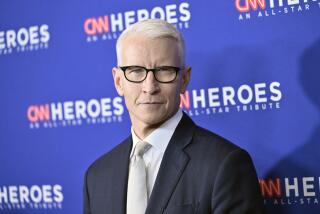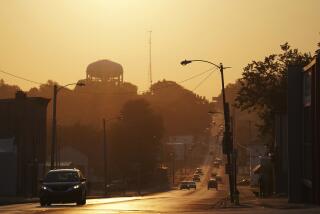In Haiti, getting there the hardest part of getting the story
Reporting from New York â As the magnitude of destruction in Haiti unfolded Wednesday, U.S. television networks scrambled to get reporters into the devastated country, a task greatly complicated by the shaky security and broken infrastructure.
With the air traffic control tower at the Port-au-Prince airport severely damaged, the biggest challenge was just getting near the epicenter of the earthquake that hit Tuesday.
CNNâs Anderson Cooper appeared to be the first television reporter to make it into the country, by hitching a ride Wednesday morning on a government helicopter from the Dominican Republic, which shares the island of Hispaniola with Haiti. The copter was nearly clipped by a plane as it approached Port-au-Prince. CBSâ Kelly Cobiella reached Haiti shortly afterward, after driving through the night on a dangerous road from the Dominican Republic.
âHaiti is not an easy place to get to on a good day,â said David Reiter, ABCâs vice president of news gathering. âWeâve tried a lot of different ways, over land and in the air, and weâre considering sea options.â
It was a predicament facing all major news organizations. The Columbia Journalism Review noted that since there are just three wire service reporters based in Haiti, the bulk of on-the-ground reporting did not begin until Wednesday morning, when the media were finally able to get into the stricken country.
News executives said that as soon as they heard the magnitude of the earthquake and that it was centered near the crowded Haitian capital, they knew it was going to be a major story. But the difficulty in reaching the country forced many networks to rely on Twitter and Skype in their initial reports -- particularly CNN, which aggressively covered the quakeâs destruction in the early hours, despite a lack of footage.
âWe got some of our first images from Facebook,â said Tony Maddox, managing director of CNN International. âItâs incredible how our business has changed. Even in a country as challenged as Haiti, still people have been able . . . to get their voices heard.â
By Wednesday afternoon, NBC anchor Brian Williams and CBS anchor Katie Couric had managed to get to Port-au-Prince. ABCâs Diane Sawyer was headed there from Afghanistan, where she had been reporting this week. They were backed up by dozens of colleagues, including Ann Curry for NBC, Robin Roberts for ABC and Jeff Glor for CBS. Fox News -- which had the first report from the Dominican Republic from correspondent Wendell Goler, who happened to be vacationing there -- dispatched Bill Hemmer, Steve Harrigan, Orlando Salinas and Jonathan Hunt to Haiti, and will send Greta Van Susteren today. CNN deployed Susan Candiotti and eight other reporters to join Cooper and Ivan Watson, who also arrived there early Wednesday.
Aside from the coverage of the wars in Iraq and Afghanistan, the story appears to be drawing the biggest U.S. television news deployment to an international crisis since the 2004 Southeast Asian tsunami.
With no American television bureaus in the poor Caribbean nation, news executives spent Wednesday frantically trying to figure out how to put generators and satellite uplinks in place, along with security teams to protect their staff. NBC turned to its corporate sister, GE Aviation, which helped the news division secure a chartered plane that flew Williams, Curry and their team from White Plains, N.Y., into Port-au-Prince.
âYouâre trying to move a small army into place, all the while knowing youâre walking into a place where all infrastructure has crumbled,â said NBC News President Steve Capus, who compared the situation in Haiti with the conditions reporters confronted in covering Hurricane Katrina. âSometimes you have to just go in and hope you can compensate the best you can.â
Bill Felling, CBSâ national editor, worked throughout the night Tuesday trying to get Couric into Haiti, finally locating a plane in the Dominican Republic. Felling said CBS News President Sean McManus didnât blink when he asked him to sign off on the cost, a sum he said was not insignificant.
âWhen big stories break you have an obligation to cover this to absolute maximum of your ability,â Felling said. âYou canât quite get the power of this until you see peopleâs faces and the extent to which they emote the pain that they are going through.â
Cooper said thatâs why he rushed to the airport Tuesday night to catch the last flight out of New York to the Dominican Republic.
âThereâs nothing sadder than someone dying on the side of the road and no one even noting their passing,â he said in an interview via cellphone from Port-au-Prince. âI feel privileged to be here, lucky to be here. I canât imagine being anywhere else. There are things that are extraordinarily horrific and signs of extraordinary strength, and thatâs important for people to know.â
While CNN went wall-to-wall on the story for much of Tuesday night, Fox News and MSNBC ran limited reports and stuck with taped programming before ramping up their coverage Wednesday.
One of the factors was the dearth of footage from Haiti in the early hours, said John Stack, vice president of news gathering at Fox News, which covered the story in the 4 p.m. PST hour but then ran Bill OâReillyâs pre-taped interview with former GOP vice presidential candidate Sarah Palin.
âIt was a tough call for our programmers because we had an interesting guest, but the news always takes priority,â Stack said. âIf they had something beyond the actual report, we would have interrupted.â
MSNBC, which ran a repeat of âHardballâ at 4 p.m. PST, didnât begin covering the quake until âThe Rachel Maddow Showâ at 6 p.m. âWhen there was a lack of pictures, it was hard to know the full scope,â Capus said. âBut I was very happy with programming once they got going.â
More to Read
Sign up for Essential California
The most important California stories and recommendations in your inbox every morning.
You may occasionally receive promotional content from the Los Angeles Times.










